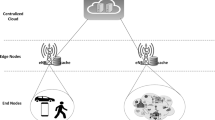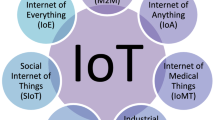Abstract
In the traditional Transmission Control Protocol/Internet Protocol (TCP/IP) stack, IP address represents not only the identifier but also the location of a node so that it can not provide global roaming seamless. To address this problem, MIP (Mobile IP) uses dynamical care-of-address to indicate the location of a mobile node (MN) and stable home address to indicate its identifier. However, such a separation of MIP can not support routing scalability, location privacy, and manageability. In this paper, we propose an identifier/locator split architecture which contains an overlay mapping system to store identifier-to-locator mappings and manage mobile nodes’ behavior. In addition, we design a novel mobility management scheme based on the identifier/locator split architecture (MMILS) which can address the above issues of MIP. To reduce the amount of signaling and enhance the performance, we distinguish micro-mobility and macro-mobility by introducing an Agent Tunnel Router (ATR). For micro-mobility, the ATR keeps the MN’s identifier-to-locator mapping invariable, so it avoids the mapping update in the mapping system and the Tunnel Route (TR) of each correspondent node. For macro-mobility, to support fast update and handover, we design a united mapping table in the ATR. And then, we estimate the number of entries and the required storage space to validate it feasible. To evaluate the efficiency of MMILS, we analyze the signaling cost by establishing an analytical model and implement it in our test-bed. The results demonstrate that the proposed scheme can effectively reduce signaling traffic and has a low handover delay compared to MIP and HMIP (Hierarchical Mobile IP).
Similar content being viewed by others
References
Balakrishnan, H., Lakshminarayanan, K., Ratnasamy, S., & Shenker, S. (2004). A layered naming architecture for the Internet. ACM SIGCOMM 2004 Conference on Computer Communications Review, 34(4), 343–352.
Johnson, D. (2004). Mobility support in IPv6. RFC 3775.
Jen, D., & Zhang, L. (2009). Understand mapping. Internet draft, draft-jen-mapping-00.
Zhang, L., Wakikawa, R., & Zhu, Z. (2009). Support mobility in the global Internet. In Proceedings of the 1st ACM workshop on mobile internet through cellular networks.
Soliman, H. (2005). Hierarchical mobile IPv6 mobility management (HMIPv6). RFC 4140.
Meyer, D., Zhang, L., & Fall, K. (2007). Report from the IAB workshop on routing and addressing. RFC4984.
Khare V., Jen D., Zhao X., Liu Y., Massey D. (2010) Evolution towards global routing scalability. IEEE Journal on Selected Areas in Communications 28(8): 1363–1375
IETF Locator/ID Separation Protocol, http://datatracker.ietf.org/wg/lisp/.
IRTF Routing Research Group, http://tools.ietf.org/group/irtf/trac/wiki/RoutingResearchGroup.
Quoitin, B., Lannone, L., Launois, C., & Bonaventure, O. (2007). Evaluating the benefits of the locator/identifier separation. In SIGCOMM MobiArch’07.
Farinacci, D., Fuller, V., Meyer, D., & Lewis, D. (2010). Locator/ID separation protocol (LISP). Internet draft, draft-ietf-lisp-09.
Moskowitz, R., & Nikander, P. (2006). Host identity protocol (HIP) architecture. RFC 4423.
Pan, J., Paul, S., Jain, R., & Bowman, M. (2008). MILSA: A mobility and multihoming supporting identifier locator split architecture for next generation internet. In Proceedings of global telecommunications conference (GLOBECOM’08).
Pan J., Jain R., Paul S., So-in C. (2010) MILSA: A new evolutionary architecture for scalability, mobility, and multihoming in the future internet. IEEE Journal on Selected Areas in Communications 28(8): 1344–1362
Farinacci, D., Fuller, V., & Meyer, D. (2010). LISP alternative topology (LISP-ALT). Internet draft, draft-fuller-lisp-alt-04.
Mathy, L., Lancaster, U., Iannone, L., & Bonaventure, O. (2008). LISP-DHT: Towards a DHT to map identifiers onto locators. Internet draft, draft-mathy-lisp-dht-00.
Luo H., Qin Y., Zhang H. (2009) A DHT-based identifier-to-locator mapping approach for a scalable Internet. IEEE Transactions on Parallel and Distributed System 20(4): 1790–1802
Jakab L., Cabellos-Aparocio A., Coras F., Saucez D., Bonaventure O. (2010) LISP-TREE: A DNS Hierarchey to Support the LISP Mapping System. IEEE Journal on Selected Areas in Communications 28(8): 1332–1343
Farinacci, D., Fuller, V., Lewis, D., & Meyer, D. (2010). LISP moblie node. Internet draft, draft-meyer-lisp-mn-01.
Jung J., Sit E., Balakrishnan H., Morris R. (2002) DNS performance and the effectiveness of caching. IEEE/ACM Transactions on Networking 10(5): 589–603
Xie J., Akyildiz I. F. (2002) A distributed dynamic regional location management scheme for mobile IP. IEEE INFOCOM 2: 1069–1078
Fang Y., Chlamtac I. C., Lin Y. B. (2000) Portable movement modeling for PCS networks. IEEE Transactions on Vehicular Technology 49(4): 1356–1363
Xie, G., Chen, J., & Zheng, H. (2007). Handover latency of MIPv6 implementation in Linux. In Proceedings of global telecommunications conference (GLOBECOM’07).
Han Y., Min S. (2009) Performance analysis of hierarchical mobile IPv6 does it improve mobile IPv6 in terms of handover speed. Wireless Personal Communication 48(4): 463–483
Fu, S., & Atiquzzaman, M. (2005). Handover latency comparison of SIGMA, FMIPv6, HMIPv6, and FHMIPv6. In Proceedings of global telecommunications conference (GLOBECOM’05).
Karpilovsky, E., & Rexford, J. (2006). Using forgetful routing to control BGP table size. In Proceedings of the 2006 ACM CoNEXT conference.
Author information
Authors and Affiliations
Corresponding author
Rights and permissions
About this article
Cite this article
Qiu, F., Li, X. & Zhang, H. Mobility Management in Identifier/Locator Split Networks. Wireless Pers Commun 65, 489–514 (2012). https://doi.org/10.1007/s11277-011-0269-8
Published:
Issue Date:
DOI: https://doi.org/10.1007/s11277-011-0269-8




